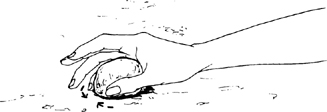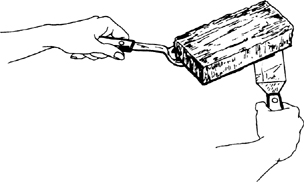Mastering the Art of French Cooking, Volume 2 (32 page)
Read Mastering the Art of French Cooking, Volume 2 Online
Authors: Julia Child

For the second stage, during which the ball of dough is rotated smooth side up, |
|
Place the formed ball of dough pucker side up on the flour-rubbed canvas and cover loosely while forming the rest. Space the balls 2 inches apart. When risen to almost triple its size, lift gently with lightly floured fingers and place pucker side down on baking sheet. Rolls are usually too small for a cross; make either one central slash or the semicircular cut.
THE SIMULATED BAKER’S OVEN
Baking in the ordinary way, as described in the preceding recipe, produces an acceptable loaf of bread, but does not nearly approach the glory you can achieve when you turn your home oven into a baker’s oven. Merely providing yourself with the proper amount of steam, if you do nothing else, will vastly improve the crust, the color, the slash patterns, and the volume of your bread; steam is only a matter of plopping a heated brick or stone into a pan of water in the bottom of the oven. The second provision is a hot surface upon which the naked dough can bake; this gives that added push of volume that improves both the appearance and the slash patterns. When you have the hot baking surface, you will then also need a paddle or board upon which you can transfer dough from canvas to hot baking surface. For the complete setup, here is what you should have, and any building-supply store stocks these items.
For the hot baking surface
Metal will not do as a hot baking surface because it burns the bottom of the dough. The most practical and easily obtainable substance is ordinary red floor tiles ¼ inch thick. They come in various sizes such as 6 by 6 inches, 6 by 3 inches, and you need only enough to line the surface of an oven rack. Look them up under
Tiles
in your directory, and ask for “quarry tiles,” their official name.
For unmolding the risen dough from its canvas
A piece of
3
⁄
16
-inch plywood about 20 inches long and 8 inches wide.
For sliding the dough onto the hot asbestos
When you are doing 3 long loaves, you must slide them together onto the hot asbestos; to do so you unmold them one at a time from the canvas with one board and arrange them side by side on the second board, which takes the place of the baker’s wooden paddle,
la pelle
. Buy a piece of
3
⁄
16
-inch plywood slightly longer but 2 inches narrower than your oven rack.
To prevent dough from sticking to unmolding and sliding boards
White cornmeal or small pasta pulverized in the electric blender until it is the consistency of table salt. This is called
fleurage
.
The steam contraption
Something that you can heat to sizzling hot on top of the stove and then slide into a pan of water in the oven to make a great burst of steam: a brick, a solid 10-lb. rock, piece of cast iron or other metal. A 9 × 12-inch roasting pan 2 inches deep to hold an inch of water and the hot brick.
Nonessential professional equipment
Instead of letting the formed dough rise on canvas,
sur couche
, many French bakers place each piece in a canvas-lined wicker or plastic form called a
banneton;
from this you turn the risen dough upside down directly onto a board and then slide it into the oven. Various sizes and shapes are available in French bakery-supply houses.
These are bakers’s blades, |
|
USING THE SIMULATED BAKER’S OVEN
At least 30 to 40 minutes before the end of the final rise, Step 7 in the Master Recipe, line the rack of your oven with quarry tiles, slide onto upper-third level,
and preheat oven to 450 degrees. At the same time set the brick or metal over very high heat on top of the stove so that it will get sizzling hot, the hotter the better.
| Provide yourself with 2 stiff spoons or spatulas, or with fire tongs for lifting brick |





